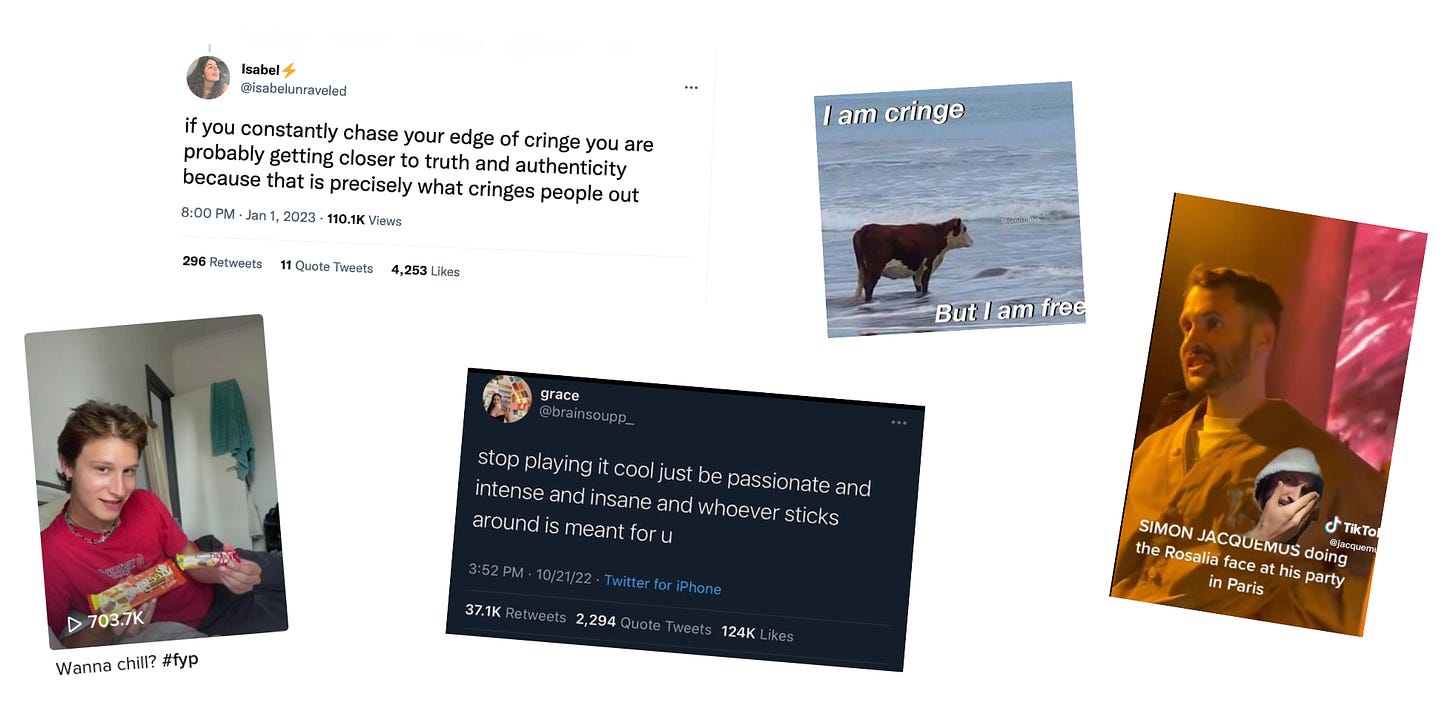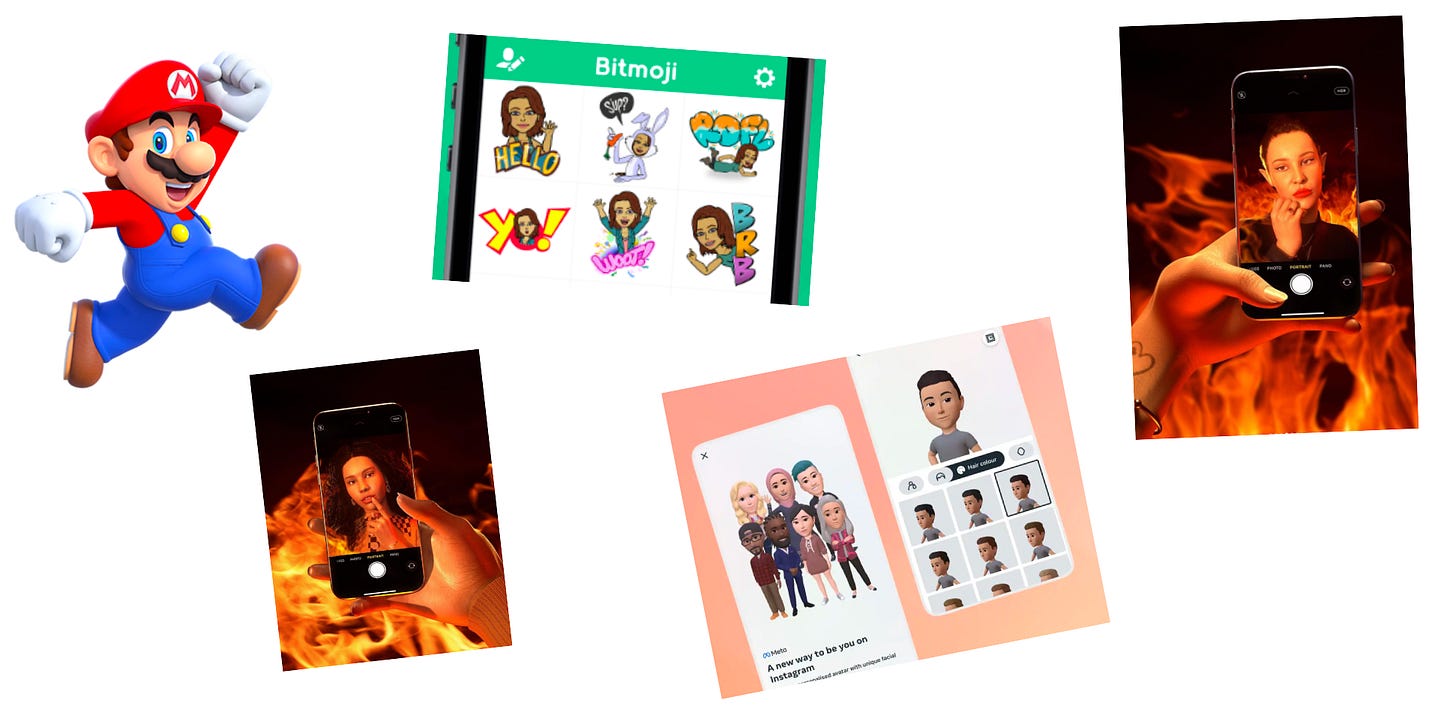013 - The Booms and Busts of Online Authenticity | Part II: The Present and Future
What's next for online authenticity, and how can brands prepare to ride the wave? We continue our dive into "the internet's most gripping trait" plus how you can use it to your advantage
… where was I? Oh yeah!
2020: Performative Authenticity = Bust
What Youtuber Emma Chamberlain pioneered, many of us contribute to today. “Relatable” content exists now as basic parts of the human experience being owned by creators (see Elsa Majimbo's signature brand of laziness and nonchalance) or turned into trends (i.e. icks). But with so many hunting for their piece of human nature to co-opt for performance, it’s all getting a bit overdone and, you guessed it, performative."
TikTok commentator Akilimoree addressed the overarching strive to be real in August 2022 (which we also reference here). But why does performative authenticity work so well? Let's take a look at two niches at the forefront of the phenomenon right now: cringe and the crying aesthetic.
As I told Elle last month - '... cringe content opens a dialogue around personal social cues. "Cringe" is a relatable conversation piece - "Oh my god, how could another human act like that?" which earns likes, comments and shares as people discuss the content. Moreover, being a bit cringe is natural. Some employ it to show one is "real", free, self-aware and/or cool, others embrace cringe to help break the shackles archetype influencers have put on us. We can’t be cool all the time and it’s more important to truly express yourself - Jacquemus knows.

When it comes to the crying aesthetic, sadness is a universal emotion we can all connect to or critique the performance of, a similar discussion cringe ignites. However, crying makeup is making gains on TikTok because its GenZ user base often copes with real problems by ironically reinterpreting them. Whether it’s making light of bad realities ("Global warming will kill us all anyway. lol”) or embracing their emotional issues (21-year-old Cat Burns has a whole song about anxiety), GenZ earns praise when they reframe. So, making sadness cute with makeup is a type of GenZ coping mechanism - like, why be sad and ugly, when you can just be sad?!?

These two cases are okay to pick out since cringe isn’t that deep of a feeling, and “crying make-up” is a superficial form of an emotion. However, some versions of this performative authenticity online are hard to navigate and could be damaging.
When is it healthy venting? When is it oversharing? When is it a lie? When is it true? When is it performative? When is it authentic?
In 2014, plucking up the courage to say something vulnerable was rare and not rewarded algorithmically. Now rawness performs so well, it’s arguable that people are not using social media to raise awareness of an issue or looking to fold in some reality into social media, but using such vulnerabilities to grow a following.
It’s givinggggggg Boy Who Cried Wolf.
Not only is it tricky to know what to take seriously, but also when or if you can call a post out. Seeing the wood through the trees, the authenticity through the algorithm is subjective, so a call out can either end tensioned or very insensitive if you’re wrong.
Anyway, I think performative authenticity is busted.
Firstly, if all of this content was totally genuine, I don’t think there would be as much journalistic veil lifting, exhibit A B C D, as there is.
Secondly, the constant trending of human niches will get overdone, similar to how “-cores' 'and “aesthetics” has (CCing Gia and “Core Core” to explain that phenomena’s demise).
Thought, I do wonder what relatable unit is going to be trended after cringe. Character flaws? Oh wait, icks have been done. Um, being admittedly gross perhaps? We’ll see.
2024: Authentically Avatars = Boom?
So, where is online authenticity heading? I think we're on to a boom, my dear Misfits.
Avatars may be the answer to online authenticity. Yes, it feels counterintuitive to think a cartoon version of yourself is the truest version of yourself - but it could be.
Avatars are not a new thing. We’ve all happily been an Italian plumber at some point in our lives, Bitmojis littered screens in 2014 and everyone at MØRNING HQ has been immortalised in CGI. The difference in the coming years is proliferation, normality and complexity of avatars.
Instagram and TikTok have casually added an avatar option in their latest updates.
Kids grew up with multiplayer gaming so used to avatars having social outcomes. Heck, they probably made a Sim before they met a Simon.
Then complexity rises with each new platform and/or ability to customise your character.

As we’ve addressed, 2012’s era of genuine authenticity and user participation was largely halted due to social (media) pressures to show off physically and materially - avatars help overcome these halts.
No longer will our online presence be at the mercy of what we look like or what we have, heck, we won’t even be in the “real” world at all. As a virtual vessel on a digital landscape, life’s social constructs are cut off, thus, rendering us down to our choices and personality. We decide what we: look like, sound like, where we exist and to what degree we use features to reflect ourselves. Online, we can dictate every inch of social projection making it wholly authentic.
Well, that is assuming you have access to the internet :)
Virtual Youtubers exemplify how avatars enable authenticity. Vtubers have amassed the kind of love and adoration that Emma Chamberlain has while not having to look a certain way or overshare. As Vtuber Mori Calliope put it, “I can unabashedly … be myself”.
Like the previous waves of authenticity, there are dangers with avatar culture. Similar to how the performance of ‘real’ content confuses a healthy share with internet-backed oversharing, avatars will also confuse what is “socially acceptable”.
Avatars create a sense of anonymity allowing extreme emotions to be explored as there is less, or no, human repercussion. I see it comparable to road rage, anger is okayed and less felt when in the bubble of a car, key-board warriorism or gamer rage, see it come off console here, noobs (jk x).

The other danger is that we don’t know what will hurt us next. Avatars expand our forms of expression, so depending on how they manifest will dictate social receptors. Will users only express through like buttons within “community guidelines”? Or will it be new realms for trolling and targeting others?
I hope this Avatar era will help people be the most authentic version of themselves and that people offline and in their corner of the internet will do what they can to prevent harm while exploring their new mediums of self.
Today: Brands = Boom or Bust?
Now we’ve done our trip down online authenticity-lane that was - let’s look forward.
As we sit in this quasi-online existence with people participating at different ends of the spectrum (no, I will not have my birthday in the metaverse, but I will expect double taps on the gram), what will this mean for authenticity at large and brands?
Authenticity
Similar to social media "listeners and posters', the avatar era will breed a duality: real lifers and onliners, each with their own forms of authenticity.
Real Lifers
Real lifers (or as the NDC put it, The Para-Real) in the real world and report it to the internet or distance their internet usage. Currently, this lives as Luddite Teens, those distancing their use of technology by adopting older techs like flip phones, and “Performative Authenticity” (scroll up).
As discussed, “Performative Authenticity” is IRL authenticity and is co-opted for social media performance and presence for "relatable" content. A specific "authenticity" is trended/owned, normalised, then breeds the next calculated (and usually out-there) form of online authenticity - a cycle. I predict this cycle will expire soon for two reasons.
Firstly, contrived "relatable" content will become see-through causing no to low engagement, but for now many will be riding the cringe hype or deciding the best way to soft launch their boyfriend in insta.
Secondly, it may cause mental health problems as people conflate emotions with algorithmic approval, amounting to complaints and government involvement resulting in a (self)regulated algorithm.
Instagram is proof of this shift. They provide the option to view content chronologically and opt out algorithmically. Over time, users will have more leavers to rear social scrolls and features to limit phoney on their phones.
Onliners
For onliners, they are leading a digital restructuring of human nature. As the internet provides more mediums of expression and connection, people will be themselves like never before. As these become common, we will have new authentic expressions and dangerous over-expression too.
I believe each virtual world and platform will host its own authenticity. People will know the difference between being self-made and illegitimate, just like how we can suss out a following that's organic or paid on Instagram or someone bossing Sims through gameplay and Ctrl+Alt motherload (you're welcome).
The different vibes of social media platforms and the rules of online games (like Fortnight) are a testament to this. You know what is and isn’t allowed, and the authentic and inauthentic acts roll out in those parameters accordingly.
Brands
I have three recommendations for brands. The first two may expire but the last is forever and probs the go-to if you want to #BeLessShit and #DoLessWork (lol).
Cater to the Real Lifers. Right now, this will be most productive. Keep on the pulse of what the “online authenticity de jour’ is, even if it is cringe, and create your version or subversion of it - or pray a brand-aligned trend pops up so you can tap in.
Experiment with Onliners. As we grow into a world where we all spend more time online and some will submit to a full existence there, dabble in the cultures. Discord, Roblox, Vtubers, NFTs, whatever. You’ll start to create a legacy and discover boundaries so you can start to map the resources you’ll need to participate in virtual lands. It’s very much the Burberry approach to things. They’re always first movers allowing them to be the “heritage” brand no matter if it's Mainland England or Minecraft.

Commit to a personality. This is the silver bullet. As platforms fracture and proliferate over time (see peak #1 here) and people evolve their calibration of on/offline life, it's paramount to have a known and distinct personality. This, like an interesting person, is memorable and transcends realms. No matter where your brand personality has started, in stores, on socials, through a cyborg, if the tone and vibe is known, drawing parallels between new spaces will be easy and people can start to imagine it in new spaces on your behalf - "Oh, X brand needs to get on this!" or "What would X brand be like on X platform?". The Palace x Need For Speed collab made sense since Palace have always used boy racer cars in their campaigns and collab with AMG in May 2021. Then, if you’re familiar with MØRNING’s branding, I am sure you can imagine what an Ai Bot by us would look like, right? (… and if you stay tuned maybe you won't have to imagine much longer).

Woof!
What a real, genuine, authentic mind fuck :) Much to think about, much to mourn about (i love u 2012!) and much to discuss about - so, what do you think?
Make sure to read Part 1 if you missed it, Subscribe for the next BAR and let us your thought in the comments or on our Insta.
Till the next time I overthink, byeeeeeeeeeeee Misfits xxxx
Word: Emily Chapps
Editor: Letty Cole





